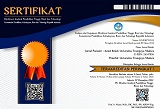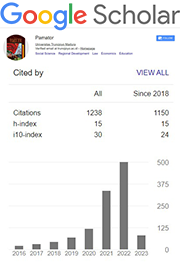Perceived Ease Of Use, Perceived Usefulness And Satisfaction To Maximize Behavioral Intention With The Technology Acceptance Model In Generation Y And Z Consumers
Abstract
Keywords
Full Text:
PDFReferences
Abbad, M. M. M. (2021). Using the UTAUT model to understand students' usage of e-learning systems in developing countries. Education and Information Technologies, 26(6), 7205–7224.
Abdennebi, H. Ben. (2023). M-banking adoption from the developing countries perspective: A mediated model. Digital Business, 3(2).
Abdul-Halim, N. A., Vafaei-Zadeh, A., Hanifah, H., Teoh, A. P., & Nawaser, K. (2022). Understanding the determinants of e-wallet continuance usage intention in Malaysia. Quality and Quantity, 56(5), 3413–3439.
Acikgoz, F., Perez-Vega, R., Okumus, F., & Stylos, N. (2023). Consumer engagement with AI-powered voice assistants: A behavioral reasoning perspective. Psychology and Marketing, 40(11), 2226–2243.
Agárdi, I., & Alt, M. A. (2022). Do digital natives use mobile payment differently than digital immigrants? A comparative study between generation X and Z. Electronic Commerce Research.
Aiolfi, S. (2023). How shopping habits change with artificial intelligence: smart speakers' usage intention. International Journal of Retail and Distribution Management, 51(9–10), 1288–1312.
Ajlouni, A. O., Wahba, F. A. A., & Almahaireh, A. S. (2023). Students' Attitudes Towards Using ChatGPT as a Learning Tool: The Case of the University of Jordan. International Journal of Interactive Mobile Technologies, 17(18), 99–117.
Al Awadhi, K., Obeidat, B., & Alshurideh, M. (2022). Measuring user acceptance of satellite broadband in the UAE. International Journal of Data and Network Science, 6(4), 1459–1470.
Al-Alwan, A. S., Li, N., Al-Adwan, A., Abbasi, G. A., Albelbisi, N. A., & Habibi, A. (2023). Extending the Technology Acceptance Model (TAM) to Predict University Students' Intentions to Use Metaverse-Based Learning Platforms. Education and Information Technologies, 28(11), 15381–15413.
Al-Adwan, A. S., Nofal, M., Akram, H., Albelbisi, N. A., & Al-Okaily, M. (2022). Toward a sustainable adoption of E-learning systems: The role of self-directed learning. Journal of Information Technology Education: Research, 21, 245–267.
Alalwan, N. (2022). Actual use of social media for engagement to enhance students' learning. Education and Information Technologies, 27(7), 9767–9789.
Alhamad, A. Q. M., Akour, I., Alshurideh, M., Al-Hamad, A. Q., Kurdi, B. Al, & Alzoubi, H. (2021). Predicting the intention to use google glass: A comparative approach using machine learning models and PLS-SEM. International Journal of Data and Network Science, 5(3), 311–320.
Almajali, D. A., Masa'Deh, R., & Dahalin, Z. M. d. (2022). Factors influencing the adoption of Cryptocurrency in Jordan: An application of the extended TRA model. Cogent Social Sciences, 8(1).
Alnemer, H. A. (2022). Determinants of digital banking adoption in the Kingdom of Saudi Arabia: A technology acceptance model approach. Digital Business, 2(2).
Al-Okaily, A., Al-Okaily, M., Ai Ping, T., Al-Mawali, H., & Zaidan, H. (2021). An empirical investigation of enterprise system user satisfaction antecedents in Jordanian commercial banks. Cogent Business and Management, 8(1).
Alqahtani, M. A., Alamri, M. M., Sayaf, A. M., & Al-Rahmi, W. M. (2022). Exploring student satisfaction and acceptance of e-learning technologies in Saudi higher education. Frontiers in Psychology, 13.
Alshebami, A. S. (2022). Crowdfunding Platforms as a Substitute Financing Source for Young Saudi Entrepreneurs: Empirical Evidence. SAGE Open, 12(3).
Alturki, U., & Aldraiweesh, A. (2023). Integrated TTF and self-determination theories in higher education: The role of actual use of massive open online courses. Frontiers in Psychology, 14.
Alyoussef, I. Y. (2023). Acceptance of e-learning in higher education: The role of task-technology fit with the information systems success model. Heliyon, 9(3).
Alzoubi, H., Alshurideh, M., Kurdi, B. Al, Akour, I., & Aziz, R. (2022). Does BLE technology contribute towards improving marketing strategies, customers' satisfaction and loyalty? The role of open innovation. International Journal of Data and Network Science, 6(2), 449–460.
Amani, D. (2022). Internal branding and students' behavioral intention to become active members of university alumni associations: the role of students' sense of belonging in Tanzania. Cogent Social Sciences, 8(1).
Amin, M., Rezaei, S., & Abolghasemi, M. (2014). User satisfaction with mobile websites: the impact of perceived usefulness (PU), perceived ease of use (PEOU) and trust. Nankai Business Review International, 5(3), 258–274.
Ariffin, S. K., Abd Rahman, M. F. R., Muhammad, A. M., & Zhang, Q. (2021). Understanding the consumer's intention to use the e-wallet services. Spanish Journal of Marketing - ESIC, 25(3), 446–461.
Asampana, I., Akanferi, A. A., Matey, A. H., & Tanye, H. A. (2022). ADOPTION OF MOBILE COMMERCE SERVICES AMONG ARTISANS IN DEVELOPING COUNTRIES. Interdisciplinary Journal of Information, Knowledge, and Management, 17, 101–123.
Atasoy, F., & Eren, D. (2023). Serial mediation: Destination image and perceived value in the relationship between perceived authenticity and behavioral intentions. European Journal of Tourism Research, 33.
Balakrishnan, J., & Dwivedi, Y. K. (2024). Conversational commerce: entering the next stage of AI-powered digital assistants. Annals of Operations Research, 333(2–3), 653–687.
Balakrishnan, J., Dwivedi, Y. K., Hughes, L., & Boy, F. (2024). Enablers and Inhibitors of AI-Powered Voice Assistants: A Dual-Factor Approach by Integrating the Status Quo Bias and Technology Acceptance Model. Information Systems Frontiers, 26(3), 921–942.
Billanes, J., & Enevoldsen, P. (2022). Influential factors to residential building occupants' acceptance and adoption of smart energy technologies in Denmark. Energy and Buildings, 276.
Burgess, J., Gilibert, D., Paul, U., Montpellier, V., João, F., Carvalho, M. S., & Lescarret, C. (2022). Coworking spaces vs. home: Does employees' experience of the negative aspects of working from home predict their intention to telework in a coworking space?
Butt, I., Mukerji, B., Shareef, M. A., Ahmed, J. U., & Huda, S. S. M. S. (2022). Effect of Trust on e-Shopping Adoption-An Emerging Market Context. Journal of Internet Commerce, 21(3), 320–340.
Caratiquit, K., & Caratiquit, L. J. (2022). Influence of Technical Support on Technology Acceptance Model to Examine the Project PAIR E-Learning System in Distance Learning Modality. Participatory Educational Research, 9(5), 468–485.
Cavalcanti, D. R., Oliveira, T., & de Oliveira Santini, F. (2022). Drivers of digital transformation adoption: A weight and meta-analysis. Heliyon, 8(2).
Chen, J. (2022). Adoption of M-learning apps: A sequential mediation analysis and the moderating role of personal innovativeness in information technology. Computers in Human Behavior Reports, 8.
Chen, Y., Khalid Khan, S., Shiwakoti, N., Stasinopoulos, P., & Aghabayk, K. (2023). Analysis of Australian public acceptance of fully automated vehicles by extending technology acceptance model. Case Studies on Transport Policy, 14.
Chocarro, R., Cortiñas, M., & Marcos-Matás, G. (2023). Teachers' attitudes towards chatbots in education: A technology acceptance model approach considering the effects of social language, bot proactiveness, and users' characteristics. Educational Studies, 49(2), 295–313.
Cresswell & Cresswell. (2022). Research Design. SAGE.
Ebadi, S., & Raygan, A. (2023). Investigating the facilitating conditions, perceived ease of use and usefulness of mobile-assisted language learning. Smart Learning Environments, 10(1).
Esawe, A. T. (2022). Understanding mobile e-wallet consumers' intentions and user behavior. Spanish Journal of Marketing - ESIC, 26(3), 363–384.
Fasbender, U., Gerpott, F. H., & Rinker, L. (2023). Getting Ready for the Future, Is It Worth It? A Dual Pathway Model of Age and Technology Acceptance at Work. Work, Aging and Retirement, 9(4), 358–375.
Fortes, N., & Rita, P. (2016). Privacy concerns and online purchasing behavior: Towards an integrated model. European Research on Management and Business Economics, 22(3), 167–176.
Fülöp, M. T., Breaz, T. O., Topor, I. D., Ionescu, C. A., & Dragolea, L. L. (2023). Challenges and perceptions of e-learning for educational sustainability in the "new normality era." Frontiers in Psychology, 14.
Gansser, O. A., & Reich, C. S. (2021). A new acceptance model for artificial intelligence with extensions to UTAUT2: An empirical study in three segments of application. Technology in Society, 65.
Gantulga, U., Sampil, B., & Tugsbat, A. (2022). Predicting RFID adoption towards urban smart mobility in Ulaanbaatar, Mongolia. Asia Marketing Journal, 24(1), 3–12.
Herzallah, D., Muñoz-Leiva, F., & Liebana-Cabanillas, F. (2022). Drivers of purchase intention in Instagram Commerce. Spanish Journal of Marketing - ESIC, 26(2), 168–188.
Hiew, L. C., Lee Hung, A., Leong, C. M., Liew, C. Y., & Soe, M. H. (2022). Do They Really Intend to Adopt E-Wallet? Prevalence Estimates for Government Support and Perceived Susceptibility. Asian Journal of Business Research, 12(1), 77–98.
Ho, N. T. T., Abdullah, M. R. T. L., Idrus, H. B., Sivapalan, S., Pham, H. H., Dinh, V. H., Pham, H. K., & Nguyen, L. T. M. (2023). Acceptance Toward Coursera MOOCs Blended Learning: A Mixed Methods View of Vietnamese Higher Education Stakeholders. SAGE Open, 13(4).
Hoang, T. D. L., Nguyen, H. T., Vu, D. T., & Le, A. T. T. (2024). The role of mindfulness in promoting purchase intention. Spanish Journal of Marketing - ESIC, 28(2), 228–247.
Huang, T. (2021). Research on the use intention of potential designers of unmanned cars based on technology acceptance model. PLoS ONE, 16(August 8).
Huang, T. (2023). Psychological factors affecting potential users' intention to use autonomous vehicles. PLoS ONE, 18(March 3).
Hussein, M. H., Hock Ow, S., & Al-Azawei, A. (2022). What drives students' successful reuse of online learning in higher education? A case of Google Classroom. Australasian Journal of Educational Technology, 38(3).
Irimia-Diéguez, A., Albort-Morant, G., Oliver-Alfonso, M. D., & Ullah, S. (2024). Predicting the intention to use Paytech services by Islamic banking users. International Journal of Islamic and Middle Eastern Finance and Management, 17(1), 1–15.
Jermsittiparsert, K., Al-Emran, M., Mugahed Al-Rahmi, A., Alturise, F., & Mugahed Al-Rahmi, W. (2022). Factors influencing the adoption of internet banking: An integration of ISSM and UTAUT with price value and perceived risk. Frontiers in Psychology, 13.
Kampa, R. K. (2023). Combining technology readiness and acceptance model for investigating the acceptance of m-learning in higher education in India. Asian Association of Open Universities Journal, 18(2), 105–120.
Kim, J. H., Kim, M., Park, M., & Yoo, J. (2021). How interactivity and vividness influence consumer virtual reality shopping experience: the mediating role of telepresence. Journal of Research in Interactive Marketing, 15(3), 502-525. https://doi.org/10.1108/JRIM-07-2020-0148
Lai, Y., Saab, N., & Admiraal, W. (2022). University students' use of mobile technology in self-directed language learning: Using the integrative model of behavior prediction. Computers and Education, 179. https://doi.org/10.1016/j.compedu.2021.104413
Li, B. J., Lee, E. W. J., Goh, Z. H., & Tandoc, E. (2022). From frequency to fatigue: Exploring the influence of videoconference use on videoconference fatigue in Singapore. Computers in Human Behavior Reports, 7. https://doi.org/10.1016/j.chbr.2022.100214
Li, L., Lee, K. Y., Emokpae, E., & Yang, S.-B. (n.d.). What makes you continuously use chatbot services? Evidence from chinese online travel agencies. https://doi.org/10.1007/s12525-020-00454-z/Published
Li, R. (2021). Modeling the Continuance Intention to Use Automated Writing Evaluation Among Chinese EFL Learners. SAGE Open, 11(4). https://doi.org/10.1177/21582440211060782
Liaw, S.-S. (2002). Understanding user perceptions of World-wide web environments. In Journal of Computer Assisted Learning (Vol. 18).
Lin, E. Y. C., Hsu, H. T., & Chen, K. T. C. (2023). Factors that influence students' acceptance of mobile learning for EFL in higher education. Eurasia Journal of Mathematics, Science and Technology Education, 19(6). https://doi.org/10.29333/EJMSTE/13219
Madinga, N. W., Blanckensee, J., Longhurst, L., & Bundwini, N. (2023). The new normal: the adoption of food delivery apps. European Journal of Management Studies, 28(3), 175-192. https://doi.org/10.1108/ejms-03-2023-0021
Maqableh, M., Jaradat, M., & Azzam, A. (2021). Exploring the determinants of students' academic performance at university level: The mediating role of internet usage continuance intention. Education and Information Technologies, 26(4), 4003-4025. https://doi.org/10.1007/s10639-021-10453-y
Mariani, M. M., Ek Styven, M., & Teulon, F. (2021). Explaining the intention to use digital personal data stores: An empirical study. Technological Forecasting and Social Change, 166. https://doi.org/10.1016/j.techfore.2021.120657
Mariano, J., Marques, S., Ramos, M. R., Gerardo, F., Cunha, C. L. da, Girenko, A., Alexandersson, J., Stree, B., Lamanna, M., Lorenzatto, M., Mikkelsen, L. P., Bundgård-Jørgensen, U., Rêgo, S., & de Vries, H. (2022). Too old for technology? Stereotype threat and technology use by older adults. Behavior and Information Technology, 41(7), 1503-1514. https://doi.org/10.1080/0144929X.2021.1882577
Marsasi, E. G., Albari, A., & Muthohar, M. (2023). How Utilitarian Motivation and Trust Can Increase Intention to Use Based on Functional Attitude Theory. International Journal of Professional Business Review, 8(12), e04086. https://doi.org/10.26668/businessreview/2023.v8i12.4086
Marsasi, E. G., & Barqiah, S. (2023). The Role of Gender, Age, and Educational Groups in Utilitarian Motivation for Sharia Products. Indonesian Journal of Business and Entrepreneurship. https://doi.org/10.17358/ijbe.9.1.104
Mew, J., & Millan, E. (2021). Mobile wallets: key drivers and deterrents of consumers' intention to adopt. International Review of Retail, Distribution and Consumer Research, 31(2), 182-210. https://doi.org/10.1080/09593969.2021.1879208
Mishra, A., Shukla, A., Rana, N. P., Currie, W. L., & Dwivedi, Y. K. (2023). Re-examining the post-acceptance model of information systems continuance: A revised theoretical model using MASEM approach. International Journal of Information Management, 68. https://doi.org/10.1016/j.ijinfomgt.2022.102571
Mohammadi, S., Krystian Grajek, M., Paola Rojas Gil, A., Lahiri, A., Suman Jha, S., Dobe, M., & Taklikar, C. (2023). School-based intervention on behavioral intention of adolescents regarding healthy diet in India. https://doi.org/https://doi.org/10.3389/fpubh.2023.1094960
Nakisa, B., Ansarizadeh, F., Oommen, P., & Kumar, R. (2023). Using an extended technology acceptance model to investigate facial authentication. Telematics and Informatics Reports, 12. https://doi.org/10.1016/j.teler.2023.100099
Obeso, M., Pérez-Pérez, M., García-Piqueres, G., & Serrano-Bedia, A. M. (2023). Enhancing students' learning outcomes through smartphones: A case study of using instagram in higher management education. International Journal of Management Education, 21(3). https://doi.org/10.1016/j.ijme.2023.100885
Obidat, A., Almahameed, M., & Alalwan, M. (2022). An empirical examination of factors affecting the post-adoption stage of mobile wallets by consumers: A perspective from a developing country. Canada. Decision Science Letters, 11, 273-288. https://doi.org/10.5267/dsl.2022.2.005
Odusanya, K., Aluko, O., & Lal, B. (2022). Building Consumers' Trust in Electronic Retail Platforms in the Sub-Saharan Context: an exploratory study on Drivers and Impact on Continuance Intention. Information Systems Frontiers, 24(2), 377-391. https://doi.org/10.1007/s10796-020-10043-2
Panyekar, A., & Marsasi, G. (2024). The Role of Brand Equity, Brand Authenticity, Brand Trust to Increase Customer Satisfaction. JPEK (Journal of Economic Education and Entrepreneurship), 8(1). https://doi.org/10.29408/jpek.v8i1.25144
Pellegrino, A., Abe, M., & Shannon, R. (2022). The Dark Side of Social Media: Content Effects on the Relationship Between Materialism and Consumption Behaviors. Frontiers in Psychology, 13. https://doi.org/10.3389/fpsyg.2022.870614
Peng, M. Y. P., & Yan, X. (2022). Exploring the Influence of Determinants on Behavior Intention to Use of Multiple Media Kiosks Through Technology Readiness and Acceptance Model. Frontiers in Psychology, 13. https://doi.org/10.3389/fpsyg.2022.852394
Pereira, R., & Tam, C. (2021). Impact of enjoyment on the usage continuance intention of video-on-demand services. Information and Management, 58(7). https://doi.org/10.1016/j.im.2021.103501
Qalati, S. A., Qureshi, N. A., Ostic, D., & Sulaiman, M. A. B. A. (2022). An extension of the theory of planned behavior to understand factors influencing Pakistani households' energy-saving intentions and behavior: a mediated-moderated model. Energy Efficiency, 15(6). https://doi.org/10.1007/s12053-022-10050-z
Rahman, S. ur, Nguyen-Viet, B., Nguyen, Y. T. H., & Kamran, S. (2024). Promoting fintech: driving developing country consumers' mobile wallet use through gamification and trust. International Journal of Bank Marketing, 42(5), 841-869. https://doi.org/10.1108/IJBM-01-2023-0033
Ratilla, M., Dey, S. K., & Chovancová, M. (2021). The sharing economy and the antecedents of resource sharing intentions: Evidence from a developing country. Cogent Business and Management, 8(1). https://doi.org/10.1080/23311975.2021.1997245
Rekha, I. S., Shetty, J., & Basri, S. (2023). Students' continuance intention to use MOOCs: empirical evidence from India. Education and Information Technologies, 28(4), 4265-4286. https://doi.org/10.1007/s10639-022-11308-w
Rodríguez-Espíndola, O., Chowdhury, S., Dey, P. K., Albores, P., & Emrouznejad, A. (2022). Analysis of the adoption of emergent technologies for risk management in the era of digital manufacturing. Technological Forecasting and Social Change, 178. https://doi.org/10.1016/j.techfore.2022.121562
Saha, P., Nath, A., Kwiatkowski, G., & Oklevik, O. (2021). In search of optimum stimulation at sport events. Journal of Sport and Tourism, 25(2), 83-103. https://doi.org/10.1080/14775085.2021.1877565
Saskia Aulia, N., & Marsasi, G. (2024). The Role of Perceived Usefulness, Perceived Ease of Use, and Task Technology Fit to Increase Perceived Impact on Learning. In Nur Saskia Aulia (Vol. 163). https://ejournal.um-sorong.ac.id/index.php/sentralisasi/article/view/3031/1618
Scoop.market.us. (2024). Video Conferencing Statistics 2024 By Connecting Technology. https://scoop.market.us/video-conferencing-statistics/
Sevilmiş, A., Özdemir, İ., García-Fernández, J., & Zhang, J. J. (2022). Examining the Relationships Among Perceived Quality, Perceived Value, Customer Satisfaction, and Behavioral Intention in Turkish Fitness Centers. Physical Culture and Sport, Studies and Research, 96(1), 40-54. https://doi.org/10.2478/pcssr-2022-0018
Shaliha, I., & Gunanto Marsasi, E. (2024). The Influence of Attitude and Perceived Risk to Optimize Intention to Adopt Based on Theory of Planned Behavior in Generation Z. Ekombis Review: Scientific Journal of Economics and Business, 12(2), 1679-1694. https://doi.org/10.37676/ekombis.v12i2
Sinha, N., & Singh, N. (2023). Moderating and mediating effect of perceived experience on merchant's behavioral intention to use mobile payments services. Journal of Financial Services Marketing, 28(3), 448-465. https://doi.org/10.1057/s41264-022-00163-y
Songkram, N., Chootongchai, S., Osuwan, H., Chuppunnarat, Y., & Songkram, N. (2023). Students' adoption towards behavioral intention of digital learning platform. Education and Information Technologies, 28(9), 11655-11677. https://doi.org/10.1007/s10639-023-11637-4
Sousa, M., Gonçalves, C., Biscaia, R., & Carvalho, M. J. (2024). Service quality, satisfaction and behavioral intentions in sport child camps: participants' and parents' perspectives. International Journal of Sports Marketing and Sponsorship, 25(1), 18-41. https://doi.org/10.1108/IJSMS-10-2022-0183
Tamilmani, K., Rana, N. P., Nunkoo, R., Raghavan, V., & Dwivedi, Y. K. (2022). Indian Travelers' Adoption of Airbnb Platform. Information Systems Frontiers, 24(1), 77-96. https://doi.org/10.1007/s10796-020-10060-1
Tandon, A., Kaur, P., Bhatt, Y., Mäntymäki, M., & Dhir, A. (2021). Why do people purchase from food delivery apps? A consumer value perspective. Journal of Retailing and Consumer Services, 63. https://doi.org/10.1016/j.jretconser.2021.102667
Techrepublic.com. (2021). Zoom tops Google Meet, Microsoft Teams, and Skype in one ranking. https://www.techrepublic.com/article/zoom-zips-ahead-of-google-meet-microsoft-teams-and-skype-in-one-ranking/
Uma Sekaran & Roger Bougie. (2020). Research Methods for Business. www.wileypluslearningspace.com
Wiganda, S., & Marsasi, E. G. (2023). How Gratitude and Self-Image Congruency Can Affect the Satisfaction, Trust and Affective Commitment? MIX: A SCIENTIFIC JOURNAL OF MANAGEMENT, 13(2), 288. https://doi.org/10.22441/jurnal_mix.2023.v13i2.003
Xiang, H., Chau, K. Y., Iqbal, W., Irfan, M., & Dagar, V. (2022). Determinants of Social Commerce Usage and Online Impulse Purchase: Implications for Business and Digital Revolution. Frontiers in Psychology, 13. https://doi.org/10.3389/fpsyg.2022.837042
Yin, L. X., & Lin, H. C. (2022). Predictors of customers' continuance intention of mobile banking from the perspective of the interactivity theory. Economic Research-Ekonomska Istrazivanja, 35(1), 6820-6849. https://doi.org/10.1080/1331677X.2022.2053782
Yu, C. W., Chao, C. M., Chang, C. F., Chen, R. J., Chen, P. C., & Liu, Y. X. (2021). Exploring Behavioral Intention to Use a Mobile Health Education Website: An Extension of the UTAUT 2 Model. SAGE Open, 11(4). https://doi.org/10.1177/21582440211055721
Yu, X., Cheng, X., Kim, K. H., & Wang, H. (2024). Exploring the brand experience in the metaverse under the perspective of technology acceptance model. Asia Pacific Journal of Marketing and Logistics. https://doi.org/10.1108/APJML-10-2023-0952
Zhao, H., & Khan, A. (2022). The Students' Flow Experience with the Continuous Intention of Using Online English Platforms. Frontiers in Psychology, 12. https://doi.org/10.3389/fpsyg.2021.807084
Zhou, Q., Sotiriadis, M., & Shen, S. (2023). Using TikTok in tourism destination choice: A young Chinese tourists' perspective. Tourism Management Perspectives, 46. https://doi.org/10.1016/j.tmp.2023.101101
Zygiaris, S., Hameed, Z., Ayidh Alsubaie, M., & Ur Rehman, S. (2022). Service Quality and Customer Satisfaction in the Post Pandemic World: A Study of Saudi Auto Care Industry. Frontiers in Psychology, 13. https://doi.org/10.3389/fpsyg.2022.842141
DOI: https://doi.org/10.21107/pamator.v18i1.29461
Refbacks
- There are currently no refbacks.
Copyright (c) 2025

This work is licensed under a Creative Commons Attribution-ShareAlike 4.0 International License.
Jurnal Pamator : Jurnal Ilmiah Universitas Trunojoyo by Universitas Trunojoyo Madura is licensed under a Creative Commons Attribution-ShareAlike 4.0 International License.















.png)